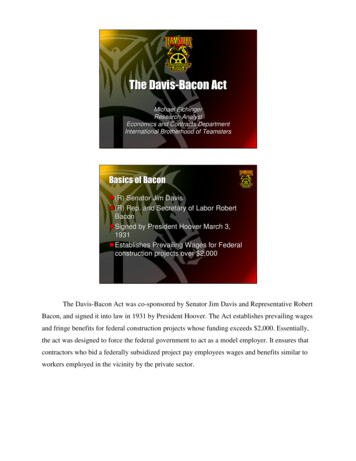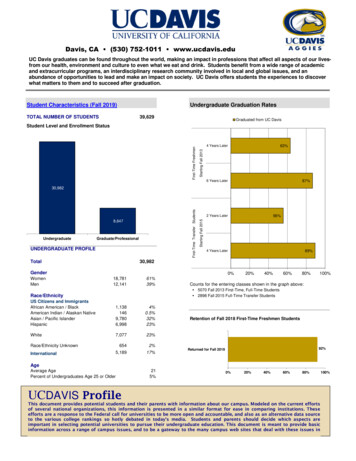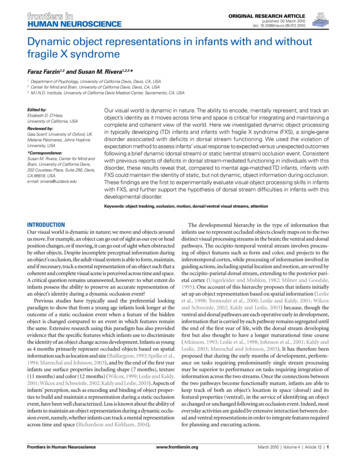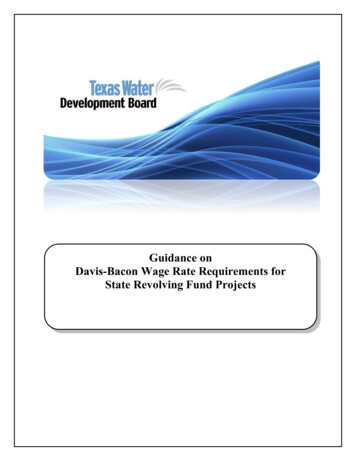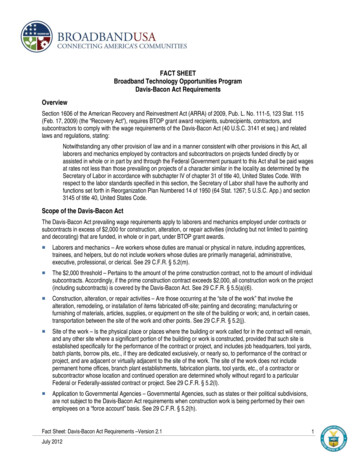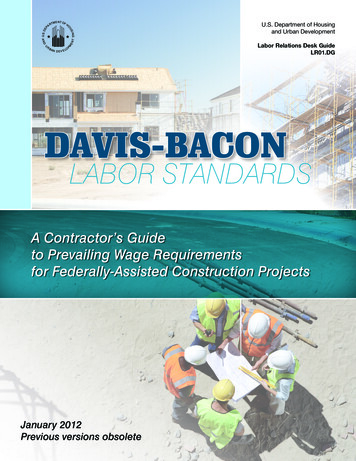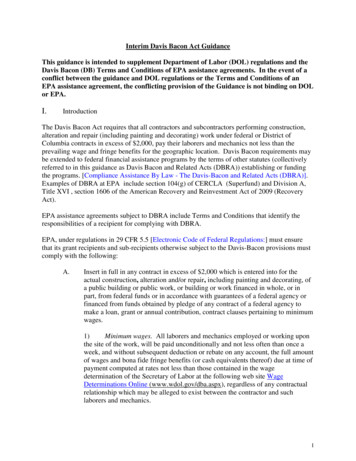
Transcription
U.S. Department of Housingand Urban DevelopmentLabor Relations Desk GuideLR01.DGDAVIS-BACONLABOR STANDARDSA Contractor’s Guideto Prevailing Wage Requirementsfor Federally-Assisted Construction ProjectsJanuary 2012Previous versions obsolete
INTRODUCTIONThis Guide has been prepared for you as a contractor performing work on construction projectsthat are assisted by the Department of Housing and Urban Development and subject to DavisBacon prevailing wage requirements. This Guide does not address contractor requirementsinvolved in direct Federal contracting where HUD or another Federal agency enters into aprocurement contract. In this latter case, the Federal Acquisition Regulations (FAR) are applicable. While the guidance contained in this Guide is generally applicable to any Davis-Baconcovered project, specific questions pertaining to direct Federal contracts should be addressedto the Contracting Officer who signed the contract for the Federal agency.Our objective here is to provide you with a guide which is simple and non-bureaucratic yetcomprehensive and which will help you better understand and comply with Davis-Bacon laborstandards. HUD’s Office of Labor Relations worked closely with the Department of Labor’sWage and Hour Division to make sure that the labor standards provisions in your contract andthe specifics of complying with them represent the latest information. It is the Department ofLabor which has general administrative oversight of all Federal contracting agencies, such asHUD, which administer the day-to-day responsibilities of enforcing Davis-Bacon provisions inconstruction contracts they either fund or assist in funding.There are three chapters in this Guide. The first chapter offers a brief description of the lawsand regulations associated with Federal labor standards administration and enforcement anddiscusses both what’s in your contract that requires Davis-Bacon compliance and your responsibilities. The second chapter deals with labor standards and payroll reporting requirements.The third chapter discusses what can happen in the event there is a dispute about the wagerates that should be (or have been) paid and any back wages that may be due.Finally, not all HUD construction projects are covered by Davis-Bacon wage rates. For the purpose of this Guide, we are assuming that a determination has already been made that DavisBacon wage rates are applicable. Should you wish assistance in determining whether DavisBacon wage rates apply to a particular project or if you need other related technical assistance,please consult with the HUD Labor Relations Field staff for your area. If you don’t know whichstaff to contact, a list of Labor Relations field offices and their geographic areas and telephonenumbers can be found on HUD’s Home Page at the address below.Visit the Office of Labor Relations on-line:http://www.hud.gov/offices/olrObtain additional copies of this Guide and other publications at our website or by telephonefrom HUD’s Customer Service Center at (800)767-7468.i
TABLE OF CONTENTSINTRODUCTION.iCHAPTER 11-11-21-31-41-5LAWS, REGULATIONS, CONTRACTSAND RESPONSIBILITIES.1-1DAVIS-BACON AND OTHER LABOR LAWS.1-1a. The Davis-Bacon Act (DBA).1-1b. The Contract Work Hours and Safety Standards Act (CWHSSA).1-1c. The Copeland Act (Anti-Kickback Act).1-2d. The Fair Labor Standards Act (FLSA).1-2DAVIS-BACON REGULATIONS.1-2CONSTRUCTION CONTRACT PROVISIONS.1-2RESPONSIBILITY OF THE PRINCIPAL CONTRACTOR.1-3RESPONSIBILITY OF THE CONTRACT ADMINISTRATOR.1-4CHAPTER 2HOW TO COMPLY WITH LABOR STANDARDSAND PAYROLL REPORTING REQUIREMENTS.2-1SECTION - I THE BASICS2-12-22-32-4THE WAGE DECISION.2-1a. The work classifications and wage rates.2-1b. Posting the wage decision.2-2ADDITIONAL “TRADE” CLASSIFICATIONS AND WAGE RATES. 2-2a. Additional classification rules.2-2b. Making the request.2-3c. HUD review.2-3d. DOL decision.2-3CERTIFIED PAYROLL REPORTS.2-4a. Payroll formats.2-4b. Payroll certifications.2-4c. “No work” payrolls.2-4d. Payroll review and submission.2-5e. Payroll retention.2-5f. Payroll inspection.2-5DAVIS-BACON DEFINITIONS.2-5a. Laborer or mechanic.2-5b. Employee.2-6c. Apprentices and trainees.2-6d. Prevailing wages or wage rates.2-7e. Fringe benefits.2-7f. Overtime.2-7g. Deductions.2-8h. Proper designation of trade.2-8i. Site of work.2-8iii
SECTION - II REPORTING REQUIREMENT2-5COMPLETING A PAYROLL REPORT.2-9a. Project and contractor/subcontractor information.2-9b. Employee information.2-9c. Work classification.2-9d. Hours worked.2-10e. Rate of pay.2-10f. Gross wages earned.2-10g. Deductions.2-11h. Net pay.2-11i. Statement of compliance.2-11j. Signature.2-11SECTION III - PAYROLL REVIEWS AND CORRECTIONS2-62-72-8ivCOMPLIANCE REVIEWS.2-12a. On-site interviews.2-12b. Project payroll reviews.2-12TYPICAL PAYROLL ERRORS AND REQUIRED CORRECTIONS. 2-12a. Inadequate payroll information.2-12b. Missing identification numbers.2-12c. Incomplete payrolls.2-13d. Classifications.2-13e. Wage Rates.2-13f. Apprentices and trainees.2-13g. Overtime.2-13h. Computations.2-13i. Deductions.2-13j. Fringe benefits.2-14k. Signature.2-14l. On-site interview comparisons.2-14m. Correction certified payroll.2-14RESTITUTION FOR UNDERPAYMENT OF WAGES.2-14a. Notification.2-14b. Computing wage restitution.2-15c. Correction certified payrolls.2-15d. Review of correction CPR.2-15e. Unfound workers.2-15
CHAPTER 33-13-23-33-43-53-6LABOR STANDARDS DISPUTES, ADMINISTRATIVEREVIEWS, WITHHOLDING, DEPOSITS AND ESCROWACCOUNTS, AND SANCTIONS.3-1INTRODUCTION.3-1ADMINISTRATIVE REVIEW ON LABOR STANDARDS DISPUTES. 3-1a. Additional classifications and wage rates.3-1b. Findings of underpayment.3-2WITHHOLDING.3-2DEPOSITS AND ESCROWS.3-3ADMINISTRATIVE SANCTIONS.3-4a. DOL debarment.3-4b. HUD sanctions.3-4FALSIFICATION OF CERTIFIED PAYROLL REPORTS.3-5APPENDICIESACRONYMS AND SYMBOLS.A-1DAVIS-BACON - RELATED WEB SITES*.A-2HUD-4720, Project Wage Rate Sheet.A-3WH-347, Payroll Form/Statement of Compliance.A-4v
CHAPTER 1LAWS, REGULATIONS, CONTRACTSAND RESPONSIBILITIESThe following paragraphs describe what the labor standards laws and regulations actually sayand what they mean to you on HUD projects:1-1DAVIS-BACON AND OTHER LABOR LAWS.a. The Davis-Bacon Act (DBA). The Davis-Bacon Act requires the payment of prevailingwage rates (which are determined by the U.S. Department of Labor) to all laborers andmechanics on Federal government and District of Columbia construction projects inexcess of 2,000. Construction includes alteration and/or repair, including painting anddecorating, of public buildings or public works.Most HUD construction work is not covered by the DBA itself since HUD seldom contractsdirectly for construction services. Most often, if Davis-Bacon wage rates apply to a HUDproject it is because of a labor provision contained in one of HUD’s “Related Acts” suchas the U. S. Housing Act of 1937, the National Housing Act, the Housing and CommunityDevelopment Act of 1974, the National Affordable Housing Act of 1990, and the NativeAmerican Housing Assistance and Self-Determination Act of 1996. The Related Acts areoften referred to as the Davis-Bacon and Related Acts or DBRA.b. The Contract Work Hours and Safety Standards Act (CWHSSA). CWHSSArequires time and one-half pay for overtime (O/T) hours (over 40 in any workweek)worked on the covered project. The CWHSSA applies to both direct Federalcontracts and to indirect Federally-assisted contracts except where the assistanceis solely in the nature of a loan guarantee or insurance.CWHSSA violationscarry a liquidated damages penalty ( 10/day per violation). Intentional violationsof CWHSSA standards can be considered for Federal criminal prosecution.CWHSSA does not apply to prime contracts of 100,000 or less. In addition, some HUDprojects are not covered by CWHSSA because some HUD programs only provide loanguarantees or insurance. CWHSSA also does not apply to construction or rehabilitationcontracts that are not subject to Federal prevailing wage rates (e.g., Davis-Bacon wagerates, or HUD-determined rates for operation of public housing and Indian block grantassisted housing). However, even though CWHSSA overtime pay is not required, FairLabor Standards Act (FLSA) overtime pay is probably still applicable. (See also LaborRelations Letter SL-95-01, CWHSSA Coverage threshold for overtime and health andsafety provision, available on-line at the HUD Labor Relations Library at: www.hud.gov/offices/olr/library.cfm)1-1
c. The Copeland Act (Anti-Kickback Act). The Copeland Act makes it a Federal crimefor anyone to require any laborer or mechanic (employed on a Federal or Federallyassisted project) to kickback (i.e., give up or pay back) any part of their wages. TheCopeland Act requires every employer (contractors and subcontractors) to submitweekly certified payroll reports (CPRs) and regulates permissible payroll deductions.d. The Fair Labor Standards Act (FLSA). The FLSA contains Federal minimum wagerates, overtime (O/T), and child labor requirements. These requirements generally applyto any labor performed. The DOL has the authority to administer and enforce FLSA.HUD will refer to the DOL any possible FLSA violations that are found on HUD projects.1-2DAVIS-BACON REGULATIONS.The Department of Labor (DOL) has published rules and instructions concerningDavis-Bacon and other labor laws in the Code of Federal Regulations (CFR). Theseregulations can be found in Title 29 CFR Parts 1, 3, 5, 6 and 7. Part 1 explains howthe DOL establishes and publishes DBA wage determinations (aka wage decisions) andprovides instructions on how to use the determinations. Part 3 describes Copeland Actrequirements for payroll deductions and the submission of weekly certified payroll reports.Part 5 covers the labor standards provisions that are in your contract relating to DavisBacon Act wage rates and the responsibilities of contractors and contracting agencies toadminister and enforce the provisions. Part 6 provides for administrative proceedingsenforcing Federal labor standards on construction and service contracts. Last, Part 7sets parameters for practice before the Administrative Review Board. These regulationsare used as the basis for administering and enforcing the laws.DOL Regulations are available on-line on the World Wide Web:http://www.dol.gov/dol/allcfr/Title 29.htm1-3CONSTRUCTION CONTRACT PROVISIONSEach contract subject to Davis-Bacon labor standards requirements must contain laborstandards clauses and a Davis-Bacon wage decision. These documents are normallybound into the contract specifications.a. The labor standards clauses. The labor standards clauses describe the responsibilitiesof the contractor concerning Davis-Bacon wages and obligate the contractor to complywith the labor requirements. The labor standards clauses also provide for remedies inthe event of violations, including withholding from payments due to the contractor toensure the payment of wages or liquidated damages which may be found due. Thesecontract clauses enable the contract administrator to enforce the Federal labor standardsapplicable to the project. HUD has standard forms that contain contract clauses. Forexample, the HUD-2554, Supplementary Conditions to the Contract for Construction,which is issued primarily for FHA multifamily housing and other construction projects1-2
administered by HUD; the HUD-4010, Federal Labor Standards Provisions, which is usedfor CDBG and HOME projects, and the HUD-5370, General Conditions of the Contract forConstruction or the HUD-5370-EZ (construction contracts 100,000) which are used forPublic and Indian Housing projects.HUD program labor standards forms are available on-line at:www.hud.gov/offices/adm/hudclips/index.cfmb. Davis-Bacon Wage Decisions. The Davis-Bacon wage decision (or wage determination)is a listing of various construction work classifications, such as Carpenter, Electrician,Plumber and Laborer, and the minimum wage rates (and fringe benefits, where prevailing)that people performing work in those classifications must be paid.Davis-Bacon wage decisions are established by the DOL for various types of construction(e.g., residential, heavy, highway) and apply to specific geographic areas, usually acounty or group of counties. Wage decisions are modified from time to time to keep themcurrent. In most cases, when the contract is awarded or when construction begins, thewage decision is “locked-in” and no future modifications are applicable to the contract orproject involved.All current Davis-Bacon wage decisions can be accessed on-line at no cost at:http://www.wdol.gov1-4RESPONSIBILITY OF THE PRINCIPAL CONTRACTORThe principal contractor (also referred to as the prime or general contractor) is responsiblefor the full compliance of all employers (the contractor, subcontractors and any lower-tiersubcontractors) with the labor standards provisions applicable to the project. Becauseof the contractual relationship between a prime contractor and his/her subcontractors,subcontractors generally should communicate with the contract administrator only throughthe prime contractor. (See Contract Administrator, below.)To make this Guide easier to understand, the term “prime contractor” will mean theprincipal contractor; “subcontractor” will mean all subcontractors including lower-tiersubcontractors; and the term “employer” will mean all contractors as a group, includingthe prime contractor and any subcontractors and lower-tier subcontractors.1-3
1-5RESPONSIBILITY OF THE CONTRACT ADMINISTRATOR.The contract administrator is responsible for the proper administration and enforcementof the Federal labor standards provisions on contracts covered by Davis-Baconrequirements. We use this term to represent the person (or persons) who will providelabor standards advice and support to you and other project principals (e.g., the owner,sponsor, architect), including providing the proper Davis-Bacon wage decision(see 2-1, The Wage Decision) and ensuring that the wage decision and contract clausesare incorporated into the contract for construction. The contract administrator also monitorslabor standards compliance (see 2-6, Compliance Reviews) by conducting interviewswith construction workers at the job site and reviewing payroll reports, and oversees anyenforcement actions that may be required.The contract administrator could be an employee or agent of HUD, or of a city or county orpublic housing agency. For HUD projects administered directly by HUD staff, usually FHAinsured multifamily projects, the contract administrator will be the HUD Labor Relationsfield staff. But many HUD-assisted projects are administered by local contracting agenciessuch as Public Housing Agencies (PHAs), Indian tribes and tribally-designated housingentities (TDHEs), and States, cities and counties under HUD’s Community DevelopmentBlock Grant (CDBG) and HOME programs. In these cases, the contract administratorwill likely be local agency staff. In either case, the guidance for you remains essentiallythe same.The DOL also has a role in monitoring Davis-Bacon administration and enforcement. Inaddition, DOL has independent authority to conduct investigations. A DOL investigatoror other DOL representative may visit Davis-Bacon construction sites to interviewconstruction workers or review payroll information.1-4
CHAPTER 2HOW TO COMPLY WITH LABOR STANDARDSAND PAYROLL REPORTING REQUIREMENTSWHERE TO START?Now that you know you’re on a Davis-Bacon project and you knowsome of the legal and practical implications, what’s next?SECTION I - THE BASICS2-1THE WAGE DECISION.Davis-Bacon labor standards stipulate the wage payment requirements for Carpenters,Electricians, Plumbers, Roofers, Laborers, and other construction work classificationsthat may be needed for the project. The Davis-Bacon wage decision that applies to theproject contains a schedule of work classifications and wage rates that must be followed.If you don’t have it already (and by now you should), you’ll want to get a copy of theapplicable Davis-Bacon wage decision.Remember, the wage decision is contained in the contract specifications along with thelabor standards clauses. See 1-3, Construction Contract Provisions.a. The work classifications and wage rates. A Davis-Bacon wage decision is simply alisting of different work classifications and the minimum wage rates that must be paidto anyone performing work in those classifications. You’ll want to make sure that thework classification(s) you need are contained in the wage decision and make certainyou know exactly what wage rate(s) you will need to pay. Some wage decisionscover several counties and/or types of construction work (for example, residentialand commercial work) and can be lengthy and difficult to read. Contact the contractadministrator (HUD Labor Relations field staff or local agency staff) if you haveany trouble reading the wage decision or finding the work classification(s) you need.To make reading lengthy wage decisions easier for you, the contract administrator mayprepare a Project Wage Rate Sheet (HUD-4720). This Sheet is a one-page transcript thatwill show only the classifications and wage rates for a particular project. A blank copy ofa Project Wage Rate Sheet is provided for you in the appendix. Also, a fillable version ofthis form is available on-line at HUDClips (see web address in the Appendix). Contact thecontract administrator monitoring your project for assistance with a Project Wage RateSheet.2-1
b. Posting the wage decision. If you are the prime contractor, you will be responsible forposting a copy of the wage decision (or the Project Wage Rate Sheet) and a copy of theDOL Davis-Bacon poster titled Employee Rights under the Davis-Bacon Act (Form WH1321) at the job site in a place that is easily accessible to all of the construction workersemployed at the project and where the wage decision and poster won’t be destroyed bywind or rain, etc. The Employee Rights under the Davis-Bacon Act poster is available inEnglish and Spanish on-line at HUDClips (see address in the Appendix).The Employee Rights under the Davis-Bacon Act poster (WH-1321) replaces the Noticeto all Employees. The new poster is available in English and Spanish on-line at HUDClips(see address in the Appendix).2-2ADDITIONAL “TRADE” CLASSIFICATIONS AND WAGE RATES.What if the work classification you need isn’t on the wage decision? If the workclassification(s) that you need doesn’t appear on the wage decision, you will need torequest an additional classification and wage rate. This process is usually very simpleand you’ll want to start the request right away. Basically, you identify the classificationyou need and recommend a wage rate for DOL to approve for the project. There are afew rules about additional classifications; you’ll find these rules in the DOL regulations,Part 5, and in the labor clauses in your contract. The rules are summarized for you here:a. Additional classification rules.approved if:Additional classifications and wage rates can be1. The requested classification is used by construction contractors in the area of theproject. (The area is usually defined as the county where the project is located).2. The work that will be performed by the requested classification is not alreadyperformed by another classification that is already on the wage decision. (In otherwords, if there already is an Electrician classification and wage rate on the wagedecision you can’t request another Electrician classification and rate.)3. The proposed wage rate for the requested classification “fits” with the other wagerates already on the wage decision. (For example, the wage rate proposed fora trade classification such as Electrician must be at least as much as the lowestwage rate for other trade classifications already contained in the wage decision.)And,4. The workers that will be employed in the added classification (if it is known who theworkers are/will be), or the workers’ representatives, must agree with the proposedwage rate.2-2
b. Making the request. A request for additional classification and wage rate must be madein writing through the contract administrator. (If the contract administrator is a localagency, the agency will send the request to the HUD Labor Relations staff.) If you are asubcontractor, your request should also go through the prime contractor. All you need todo is identify the work classification that is missing and recommend a wage rate (usuallythe rate that employer is already paying to the employees performing the work) for thatclassification. You may also need to describe the work that the new classification willperform.c. HUD review. The HUD Labor Relations field staff will review the requested classificationand wage rate to determine whether the request meets the DOL rules outlined in paragraph2-2(a), above. If additional information or clarification is needed, the staff will contact theprime contractor (or contract administrator for local agency projects) for more information,etc. If the Labor Relations review finds that the request meets the rules, the staff will givepreliminary approval on the request and refer it to the DOL for final approval. The staffwill send to you a copy of the preliminary approval/referral letter to the DOL.If the HUD Labor Relations staff doesn’t think the request meets the rules and if agreementcan’t be reached on the proper classification or wage rate for the work described, theHUD Labor Relations staff will not approve the request. In this case, the staff will sendyour request to the DOL with an explanation why HUD believes that the request shouldn’tbe approved. The DOL still has final decision authority. You will receive a copy of thedisapproval/referral letter to the DOL.d. DOL decision. The DOL will respond to HUD Labor Relations in writing about theadditional classification and wage rate request. HUD Labor Relations will notify you ofthe DOL decision in writing. If the DOL approves the request, the prime contractor mustpost the approval notice on the job site with the wage decision.If the DOL does not approve the request, you will be notified about what classification andwage rate should be used for the work in question. You will also receive instructions abouthow to ask for DOL reconsideration if you still want to try to get your recommendationapproved.It’s always a good idea to talk to the contract administrator before submitting an additionalclassification and wage rate request. The contract administrator can offer suggestionsand advice that may save you time and increase the likelihood that DOL will approve yourrequest. Usually, the contract administrator can give you an idea about what the DOL willfinally decide.2-3
2-3CERTIFIED PAYROLL REPORTS.You’ll need to submit a weekly certified payroll report (CPR) beginning with the first weekthat your company works on the project and for every week afterward until your firm hascompleted its work. I
1-1 DAVIS-BACON AND OTHER LABOR LAWS. a. The Davis-Bacon Act (DBA). The Davis-Bacon Act requires the payment of prevailing wage rates (which are determined by the U.S. Department of Labor) to all laborers and mechanics on Federal government and District of Columbia construction projects in excess of 2,000.
